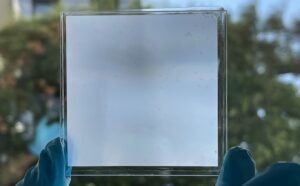1 Tiny Trick Makes Windows 4% More Transparent But Does 5 AMAZING Things! (Cool Homes, Plants Love It!)
A new ultra-thin film called PMMM can be applied to glass for amazing benefits. It lets in more light than regular glass (95% vs 91%) while diffusing it to prevent glare. This PMMM film even cools buildings by radiating heat straight into space! It’s like putting a super-powered layer on your windows.
CONTENTS: 1 Tiny Trick Makes Windows 4% More Transparent

Glass Innovation: Multifunctional Metamaterial
A recent innovation in the realm of materials science has introduced a remarkable solution for glass surfaces. Dubbed the Polymer-based Micro-photonic Multi-functional Metamaterial (PMMM), this breakthrough involves a thin film that adheres to conventional glass panes. What sets this material apart is its unique microscopic surface structure, featuring intricately etched pyramids measuring a mere 10 microns in width. This design not only enhances transparency to light but also provides added benefits such as privacy, cooling of interior spaces, and self-cleaning properties.
1 Tiny Trick Makes Windows 4% More Transparent
The miniature pyramids within the material scatter approximately 73% of incident light, resulting in a frosted appearance. However, intriguingly, this material maintains a higher transparency to light compared to standard glass, boasting a transmittance of 95% versus the typical 91% found in most glass compositions. According to the research team, this increased transparency not only enhances lighting comfort for humans but also benefits plants.
Better Light, More Benefits
Gan Huang, the study’s lead author, highlighted that employing the material in roofs and walls facilitates well-lit indoor environments that are both glare-free and safeguarded for work and living purposes. Furthermore, in greenhouse applications, the material’s exceptional light transmittance could potentially boost yields. Estimates suggest that photosynthesis efficiency may increase by as much as 9% compared to greenhouses featuring traditional glass roofs.
Cool Tricks: Radiative Cooling & Self-Cleaning
The standout feature of PMMM, perhaps its coolest trick (pun intended), is its capacity to emit heat directly into outer space, effectively cooling a room. This phenomenon, known as radiative cooling, leverages the Earth’s atmosphere’s transparency to infrared wavelengths. In practical tests, the material demonstrated its efficacy by maintaining a room 6 °C (10.8 °F) cooler than the surrounding air, utilizing the universe as a vast heat sink.
Adding to its allure, the film possesses self-cleaning capabilities. Its surface, adorned with tiny pyramids, creates a layer of air beneath water droplets, causing them to effortlessly roll off, carrying any accumulated dust or dirt. This attribute technically renders it superhydrophobic, boasting an impressive contact angle of 152 degrees.
Multifaceted Solution for Sustainable Buildings
Huang emphasized that the material offers a multifaceted approach to indoor environment optimization. By efficiently harnessing sunlight, providing passive cooling, and decreasing dependence on air conditioning, it addresses several key challenges. Moreover, its scalability and seamless integration potential make it a viable option for environmentally conscious building construction and urban development initiatives.
Check out TimesWordle.com for all the latest news
You must be logged in to post a comment.